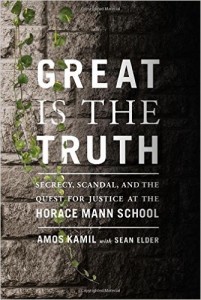Great is the Truth, by Amos Kamil with Sean Elder
This review of Amos Kamil's investigation, with Sean Elder, “Great is the Truth: Secrecy, Scandal and the Quest for Justice at the Horace Mann School,” was published November 2015 in The Seattle Times.
 The scene opens with five men around a campfire. They are school buddies, long out of touch, reconnecting on a camping trip. Staring into the flames, one makes a confession: Remember the football coach? “When we were in eighth grade, he raped me.” The man continues. “Not just me. There were a whole bunch of us.”
The scene opens with five men around a campfire. They are school buddies, long out of touch, reconnecting on a camping trip. Staring into the flames, one makes a confession: Remember the football coach? “When we were in eighth grade, he raped me.” The man continues. “Not just me. There were a whole bunch of us.”
Turns out, three of the others at that campfire had similar secrets about other teachers at their storied New York City academy.
“Great is the Truth: Secrecy, Scandal and the Quest for Justice at the Horace Mann School,” is an account of the full scale and legal wrangling around what may be the largest sexual-abuse scandal in the history of American education.
The breadth alone is shocking. To date, writes co-author Amos Kamil, 22 teachers and administrators have been credibly accused of assaulting 63 students over three decades. But the truly chilling narrative concerns the way Horace Mann, a bastion of privilege and liberalism, handled those revelations.
The school has a jaw-dropping alumni roster: William Carlos Williams and Robert Caro learned to write there; media mogul Si Newhouse and future advisers to Presidents Nixon, Ford and Carter attended. Among New York’s pantheon of prep schools, Horace Mann was the crown jewel, a place that “could take a Gatz and turn him into a Gatsby,” Kamil writes.
Did that rarefied air encourage three decades of turning away from shocking faculty behavior? Apparently so, for few teachers took pains to hide what they were doing. Quite the opposite. They invited eighth-graders over for boozy steak dinners and took high-schoolers on debauched trips to Europe.
Eccentricity was seen as a sign of brilliance. Over-familiarity, favor from on high. Troublingly, the most prolific offenders were also brilliant educators, men acknowledged to have awakened deep appreciation for philosophy, art and literature in generations of kids.
“This is what private schools sell,” says an alumnus now working at The Washington Post. “A level of intimacy and teacher involvement in the lives of kids that … can be inspiring and life-changing but that can fairly easily cross the line.”
Towering above it all was headmaster R. Inslee “Inky” Clark Jr., a progressive reformer and Kamil’s “personal savior” who lifted the future author from Bronx baseball fields to the glittering school on the hill — while condoning statutory rape by his teachers.
More troubling still, when these revelations poured out after a 2012 expose in The New York Times Magazine, also written by Kamil, well-heeled Horace Mann offered its survivors a pittance in settlement.
“They dealt with us like we were cafeteria workers who wouldn’t take a contract,” says one.
The strongest aspect of the book, which takes its title from Horace Mann’s school motto, is its ability to show the damage wrought by such violation, regardless of a victim’s station in life.
A weakness is Kamil’s self-congratulatory tone and lack of finely-drawn characters — among them the narrator, who relies on broad-strokes (“I was more of a Springsteen guy”) to stand for telling detail. But portraiture is not the aim of his book; Kamil is after honest accounting, and it’s decades overdue.
